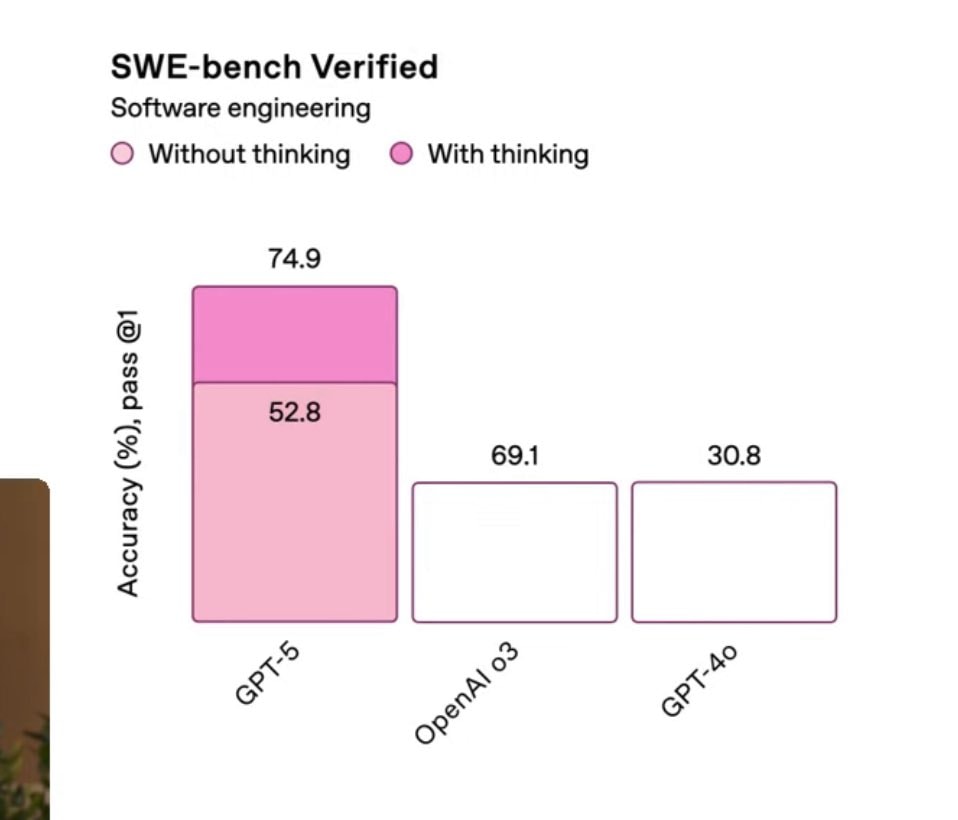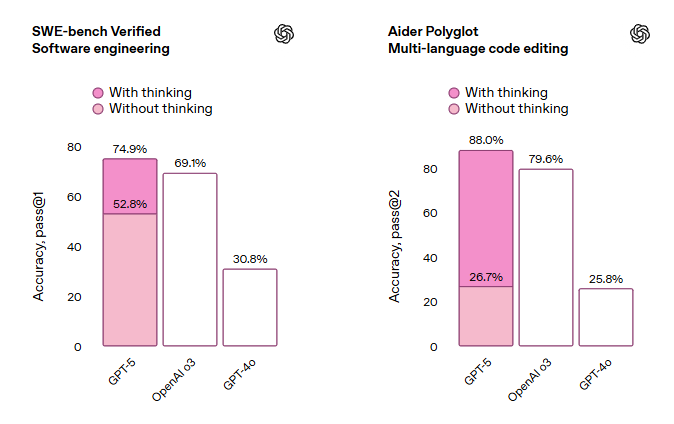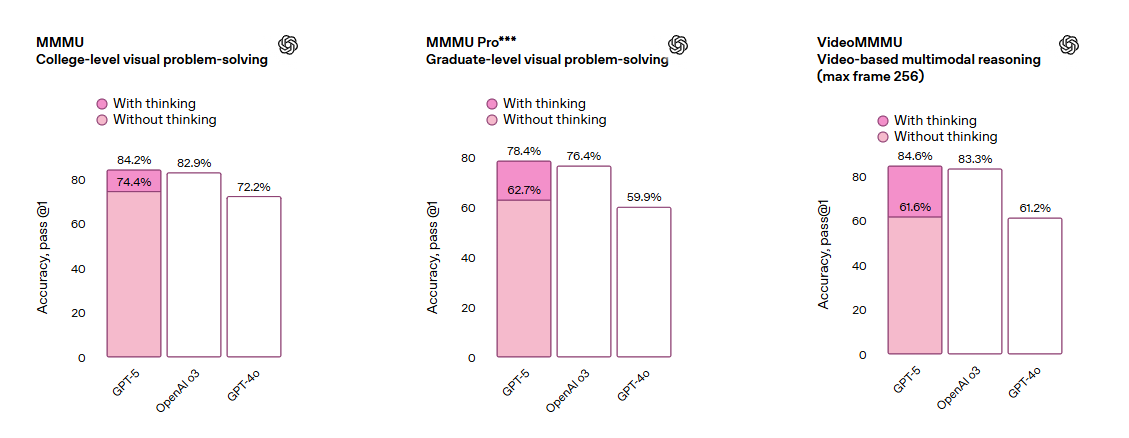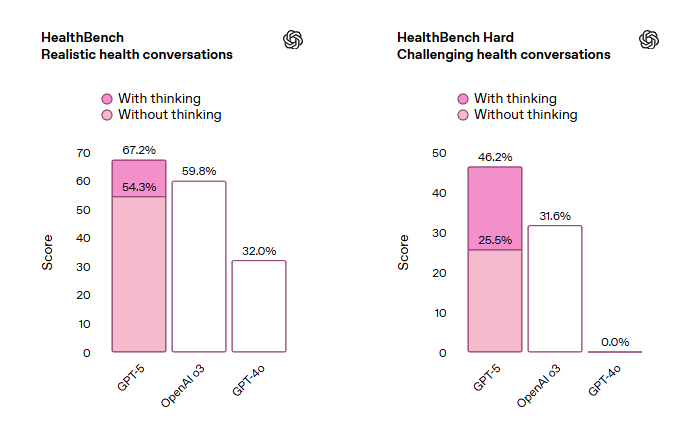Explore the key features of GPT-5, including its enhanced reasoning, multimodal capabilities, and real-world applications in coding, writing, and healthcare.
The GPT 5 release date is August 7, 2025, marking the launch of a highly anticipated AI model. GPT-5 represents a major leap forward in artificial intelligence, offering significant improvements in reasoning, multimodal capabilities, and overall performance across a wide range of tasks. Described as having PhD-level capabilities, GPT-5 sets new benchmarks in areas such as math, coding, visual perception, and health, establishing itself as the most intelligent AI model available today.
In this article, we’ll explore everything you need to know about GPT-5—from its key features and groundbreaking performance in real-world applications to its evaluations. We’ll also discuss why GPT-5 is considered the next step toward Artificial General Intelligence (AGI) and how it is reshaping the future of AI technology.
Key Features of ChatGPT 5
Unified System Architecture
Smart and Efficient Model
GPT-5 combines a fast-response model with a deeper reasoning model (GPT-5 Thinking), utilizing a real-time router to select the most appropriate model based on task complexity and user intent. This allows the system to optimize for both speed and accuracy, providing effective solutions for a wide range of tasks.
Adaptive Routing
The system dynamically adjusts to provide optimal responses, continuously improving over time through training on real user interactions. This adaptive nature ensures that GPT-5 offers the best performance across a variety of tasks and user queries.
Enhanced Reasoning Capabilities
Advanced Problem-Solving
GPT-5 excels at handling complex, multi-step problems. It can generate structured and nuanced answers across various domains, making it suitable for a variety of professional and academic use cases.
Improved Accuracy
The model has significantly reduced factual errors compared to its predecessors. This improvement in accuracy enhances GPT-5's reliability, particularly in critical applications where precision is key.
Multimodal Input and Output
Comprehensive Input Handling
GPT-5 supports multiple forms of input—text, images, audio, and video. This multimodal approach allows for a more interactive and versatile user experience, broadening the scope of tasks it can handle.
Tool Integration
GPT-5 seamlessly integrates with external tools like Gmail and Google Calendar, enabling users to efficiently handle tasks such as scheduling, email management, and information retrieval directly within the system.
Developer-Centric Enhancements
API Versions
GPT-5 offers three distinct API versions: GPT-5, GPT-5 Mini, and GPT-5 Nano. Each version caters to different performance, cost, and latency requirements, providing flexibility for developers depending on their project needs.
New Parameters
The introduction of the reasoning_effort and verbosity parameters allows developers to fine-tune the model’s responses. These parameters offer greater control over the depth and detail of the generated content.
Custom Tools
GPT-5 enables the creation of custom tools for more tailored interactions and functionalities, making it a versatile solution for developers looking to build specialized applications.
Performance Benchmarks and Real-World Applications
Coding Excellence
GPT-5 has achieved impressive results in programming benchmarks like SWE-bench Verified and Aider Polyglot, showcasing its advanced coding capabilities. The model demonstrates superior performance in tasks such as debugging, code generation, and complex algorithm design, making it an ideal tool for software development.
Creative and Professional Writing
GPT-5 excels at generating high-quality, structured content suitable for various professional contexts. Whether it's creating detailed reports, writing proposals, or crafting presentations, GPT-5 can produce content that meets the needs of businesses, academics, and creative professionals alike.
Healthcare Applications
GPT-5 is being used in healthcare for tasks such as data analysis, clinical decision support, and medical research. Organizations like Amgen have reported improved accuracy and efficiency in their operations thanks to GPT-5’s ability to process large datasets and provide insights that aid healthcare professionals in making better decisions.
GPT-5 Performance Evaluations
GPT-5's performance across a variety of academic and human-evaluated benchmarks highlights its PhD-level capabilities, setting new standards in several key areas.
Math Performance
GPT-5 achieved 94.6% on the AIME 2025 math test, significantly outperforming previous models. This score showcases GPT-5’s ability to solve complex mathematical problems with exceptional precision, establishing it as a top-tier performer in academic evaluations.

But funny things are:
- GPT-5 incorrectly claimed that 9.11 is greater than 9.9, which is a mistake that even elementary school students wouldn't make.

- During its release event, some of the graphs and figures shown, such as a bar chart where 52.8 was presented as greater than 69.1, left many puzzled, which further fueled skepticism about the model’s flawless performance in certain contexts.

Coding Excellence
In coding tasks, GPT-5 scored 74.9% on the SWE-bench Verified benchmark, demonstrating its superior performance in real-world coding applications. This score reflects its enhanced programming abilities, from debugging to algorithm design.
GPT-5 also earned an impressive 88% on Aider Polyglot, further proving its capability to handle complex, multi-language programming tasks and setting a new benchmark for AI in coding environments.

Visual Perception
GPT-5 set a new standard in multimodal understanding by achieving 84.2% on the MMMU (Multimodal Machine Understanding) benchmark. This performance highlights GPT-5’s ability to process and interpret various forms of input, including images, audio, and video, enhancing its versatility and application across diverse tasks.

Healthcare Applications
GPT-5 demonstrated significant improvements in healthcare-related tasks, scoring 46.2% on the HealthBench Hard test. This score reflects its ability to assist with medical data analysis and decision support, bringing valuable advancements to the healthcare industry.

Extended Reasoning Capabilities
GPT-5 also set a new state-of-the-art (SOTA) on GPQA, with an 88.4% score, outperforming previous models by a large margin. This benchmark tests reasoning and question-answering abilities without tools, further emphasizing GPT-5’s enhanced cognitive performance and its potential to address complex queries across multiple domains.
User Access and Limitations for GPT-5
Free Users (Free Tier)
- Message Limit: Free-tier ChatGPT users can send a maximum of 10 messages every 5 hours. Once this limit is reached, the system will automatically switch to GPT-5 Mini until the limit resets.
- GPT-5 Thinking: Free-tier users are allowed one use of GPT-5 Thinking per day.
- Feature Restrictions: Only the standard GPT-5 model is available. Users cannot manually select GPT-5 Thinking or GPT-5 Pro.
Plus Users ($20/month)
- Message Limit: Plus users can send a maximum of 80 messages every 3 hours. If this limit is reached, the system will switch to GPT-5 Mini until the limit resets.
- GPT-5 Thinking: Plus users can use 200 GPT-5 Thinking messages per week.
- Feature Restrictions: Plus users can manually select the GPT-5 Thinking model, but usage is subject to the weekly limit.
Pro Users ($200/month)
- Message Limit: Pro users have unlimited access to messages.
- GPT-5 Thinking: Unlimited access to the GPT-5 Thinking model.
- Feature Restrictions: Pro users can manually select both GPT-5 Thinking and GPT-5 Pro models, making it suitable for handling complex tasks and extended reasoning.
How to Use GPT-5: A Step-by-Step Guide
Step 1: Open ChatGPT
- Visit ChatGPT in your web browser.
Step 2: Log In or Sign Up
- If you don’t already have an account, sign up for OpenAI. If you already have an account, simply log in.
Step 3: Select the GPT-5 Model
- After logging in, you'll only see the GPT-5 model available for use, as other models have been deactivated. The GPT-5 model is the default choice for all users, and it automatically provides access to the latest features.

Step 4: Start a Conversation
- Type in your query or task in the chat box to interact with GPT-5. The system will generate a response based on your input.
FAQs about GPT-5
Q1. What is GPT-5?
GPT-5 is OpenAI's most advanced AI model to date, offering significant improvements in reasoning, multimodal capabilities, and overall performance across various tasks. It is described as having PhD-level intelligence, excelling in areas like math, coding, writing, and health.
Q2. When was GPT-5 released?
GPT-5 was officially released on August 7, 2025.
Q3. How can I access GPT-5?
You can access GPT-5 through ChatGPT or via the OpenAI API. Free-tier users have limited access, while Plus and Pro subscribers enjoy higher usage limits and access to advanced features like GPT-5 Thinking and GPT-5 Pro.
Q4. Can GPT-5 help me write software?
Yes, GPT-5 excels at generating code, debugging, and assisting with complex software development tasks. It has achieved top scores in programming benchmarks like SWE-bench Verified and Aider Polyglot.
Q5. How accurate is GPT-5?
GPT-5 demonstrates a significant reduction in factual errors compared to its predecessors. It is approximately 45% less likely to produce factual errors than GPT-4o and 80% less likely than OpenAI o3, especially when using the GPT-5 Thinking model.
Q6. Can GPT-5 understand and generate text in multiple languages?
Yes, GPT-5 is multilingual and can understand and generate text in various languages, including English, Spanish, Chinese, French, and many more. It can assist with translations, content creation, and language-related tasks.
Q7. How do I use GPT-5 in my applications?
Developers can integrate GPT-5 into their applications via the OpenAI API. By obtaining an API key and following the API documentation, you can send requests to GPT-5, integrate it into websites or apps, and create custom tools for specific use cases.
Q8. How does GPT-5 handle sensitive or inappropriate content?
GPT-5 includes safety mechanisms like "safe completions" to limit the generation of inappropriate content. While it has improved in reducing biases and harmful language, users should still exercise caution when using it for sensitive topics.
Conclusion
GPT-5 represents a monumental leap in AI technology, offering a powerful solution for a wide range of tasks. Whether you're tackling complex coding tasks, generating creative content, or engaging in structured reasoning, GPT-5 excels in delivering high-quality, efficient results. As the default model for OpenAI’s ChatGPT, it brings cutting-edge capabilities to users across all levels—making advanced AI accessible and practical for real-world applications. This new model sets new benchmarks in accuracy, versatility, and problem-solving, and it is poised to transform industries by pushing the boundaries of what AI can accomplish. With its impressive ability to handle both simple and intricate tasks, GPT-5 is truly a game-changer in the world of artificial intelligence.
